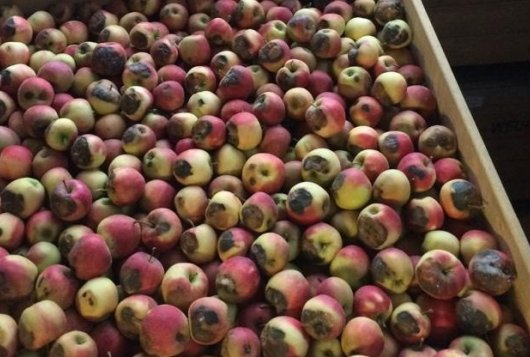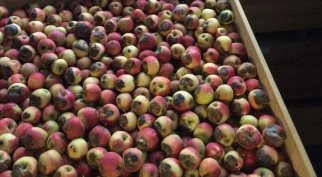
Longread
Sunburn and postharvest management on apples
It is not a surprise anymore, every year is again a warmer year then the year before. When I arrived to the Netherlands 12 years ago, as a Canadian, I found the summer not quite hot enough to be called summers. Well, I changed my mind the past 5 years. But more importantly then my personal opinion of the climate, there is a visible effect of climate change on fruit quality, and more precisely on the occurrence of disorders such as sunburn. Sunburn can occur on several fruit types such as plum, pears, strawberries, grapes, avocado, melon, pumpkins, citrus and many more. This article will focus on sunburn on apples. This also affects the postharvest management and storability of the apples.
What are the symptoms of sunburn?
Sunburn on apples can occur on a wide scale of severity and makes the apples unmarketable if too severe. Be careful, sunburn necrosis can in some cases become visible only after a few months in the cold storage. Irregular dark brown patches develop on the sun-exposed side of the apples. At this place on the apple, the peel has been stressed by the sun showing the disorder only after harvest.
One can divide the sunburn types into 3 categories:
Sunburn necrosis can occur when the fruit reaches temperature above 52°C for more than 10 minutes (see figure). This heat results in the death of peel tissue. The necrotic spot that develops is easily noticeable with its black or brown colour. This type of sunburn occurs in extreme weather. Therefore, it may become more common with climate change.

Sunburn browning is the most common type of sunburn. The peel turns yellow to brown of colour. Note that only the side exposed to the sun will change colour as opposed to a paler colour on the shadow side of the apples. The sunburn disorder is caused by a high utraviolet (UV) radiation and a high temperature. A temperature above 45°C for more than an hour can lead to this damage.
Photooxidative sunburn is a third type of apple sunburn. This type of sunburn is caused by the sudden exposition of the fruit to the sun (see figure). The peel is not used to receive direct sunlight, and as a result is more sensitive to it. Thinning or summer pruning can cause this sudden exposure to the sun. Another example is selective harvesting. The remaining apples on the tree then get suddenly exposed to direct sunlight. A situation that is also very unfortunate, is sunburn occurring on freshly picked apples in the top layer of the bin, when it stands in the orchard in the full sun.

What are secondary disorders of sunburn?
Lenticel marking disorder. Sometimes the apples that have sunburn disorders can show secondary disorders due to heat. For example lenticel marking which is more present as severity of the sunburn increases. The lenticels are becoming dark brown.
Change in internal structure of the apple. Internal browning is sometimes associated with sunburn (see figure). In fact, the sun side of the apple is becoming dryer and compacter. This leads to losses of structure of the fruit during the storage period. Sunburn has a significant influence on the storability and the quality of your fruits. This is why the detection of light sunburn on apple is becoming more and more important as consumers are demanding high quality apples year-round.

Bitter pit. The bitter pit disorder incidence can increase due to sunburn on apples in combination with a lack of water. This disorder is also increased by a lack of calcium in the fruit, which can be related to drought and hot weather.
Sunburn scald. Occurs mainly on Granny Smith. It becomes visible by the browning of the peel of the apple. The apple is still edible but often discarded from the market. The type of scald appears during cold storage where sunburn occurred before harvest.
Prevention after harvest
As sunburn cannot heal, it is important to prevent it as much as possible. There are several measures to be taken in the orchard: (hail) nets, the use of sun protectants, and overhead cooling by water sprinklers. We should not forget that sunburn can still occur after harvest!
It still happens too often. And off course during the harvest so many things have to be coordinate at the same time... and a bin or two can be left too long in the field under the sun. Keep in mind that sunburn can also occur after harvest if the fruits are not put in the shade right away. If no shade is available, think of simple ways to create it with a shade cloth. In the best case scenario, the apples should go quicker to the storage facility.

Remember to cover your apples after harvest!
What are new technologies to detect sunburn?
Of course, if the peel colour is obviously affected, the apples can easily be separated from the non-sunburned apples. However, this takes valuable time. The sorting procedure can be automized to sort out not only the obvious affected apples, but also the slightly affect ones.
Developments using non-invasive (non-destructive) technology such as near-infrared (NIR) spectrometry is under investigation. It is still a challenge to develop a system that can look at several disorders at the same time. Laser-induced chlorophyll fluorescence (LIF) can detect sunburn apples, including the ones without visible symptoms, by its lower chlorophyll fluorescence level. These technics could possibly be combined with imaging technology and artificial intelligence to offer a complete product.
Unfortunately, there are no ready-to-use solutions on the market yet. These technologies must not only be adapted for speed but also per cultivar. For this, more research and development of the technology is needed.
How to store apples with sunburn disorders?
In a perfect world, the apples with sunburn (or the risk to develop related disorders during storage) should be put apart from the other apples. And maybe not stored at all. Apples having sunburns are more sensible for external and internal CO2 damage during the storage period. Therefore, if stored, the sunburned apples should be stored separately at a lower CO2 level under CA condition or under RA regime, for a shorter period of time.
Check regularly the quality of your apples and pay attention to possible (early) signs of sunburn.